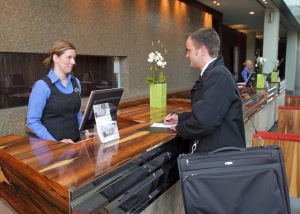After the latest incident, Wood emphasized to hotel employees the importance of their training for Intervention Procedures certification, a program designed to help employees prevent intoxication, underage drinking and  drunken driving…”A lot of people don’t understand that we are not a public place. This is a private business, and we have the right to refuse service to anyone,” Wood said. “We want to protect our guests, and that’s where our training comes into play.”
drunken driving…”A lot of people don’t understand that we are not a public place. This is a private business, and we have the right to refuse service to anyone,” Wood said. “We want to protect our guests, and that’s where our training comes into play.”
Officials at the Crowne Plaza Ventura Beach Hotel say they are re-emphasizing safety policies after the death of a 36-year-old Santa Barbara woman who recently fell from an 11th-floor balcony. The woman’s death was determined to be a suicide, according to Ventura County medical examiners. The woman fell from the balcony about 7:30 p.m. Aug. 30 and hit the roof of the C-Street Restaurant below,Ventura police said.
Douglas Wood, general manager of the Crowne Plaza, said the hotel’s balcony rails measure between 42 and 42.5 inches in height. According to guidelines set by the International Building Code, hotel balcony railings must be at least 42 inches high, and the space between rails cannot be greater than 4 inches.
Hotel balconies also must be able to withstand a strong load, to make sure the railings don’t fall down if someone pushes on them, according to the code. The Crowne Plaza meets all three standards, said Jeffrey Lambert, Ventura’s community development director.
Still, it was the seaside hotel’s third fall this year. On June 1, a 60-year-old Ventura woman committed suicide by jumping from a 12th-floor fire escape staircase. On Jan. 13, a man suffered severe injuries after falling off a balcony and hitting a concrete pool deck.
After the June incident, Wood said, the hotel decided to install tempered glass along the fire escape staircase.
Wood said there are no plans to change the structure of the balconies. The hotel underwent a complete renovation in 2006.
Former requirements call for balcony rails to be at least 36 inches tall and no greater than 6 inches apart, said Chad Callaghan, a security consultant for the American Hotel and Lodging Association.
Some hotels have taken other preventive measures, such as restricting roof access, checking later on guests who seem troubled when checking in, and doing away with patio furniture on balconies, which may invite children to climb on top of them, Callaghan said.
Other hotels have placed labels on sliding-glass doors warning parents to watch their children and never leave them unattended on the balcony, he said. Sliding-glass doors at the Crowne Plaza have a sticker in the shape of a palm tree to protect guests from walking into the glass.
“No matter what type of railing a hotel room may have, there is no substitute for common sense and good parenting,” Callaghan said.
And despite laws designed to protect hotel guests from injuries and falls, officials say, suicides may be unavoidable.
“The hotel has a responsibility to protect guests. They don’t have a legal duty to provide reasonable protection against suicides,” Callaghan said. “If a person wants to commit suicide, they’re going to find a way to do it.”
Read more:Â http://www.vcstar.com/news/2012/sep/09/ventura-hotel-re-emphasizes-safety-policies-fall/#ixzz264jtAdSi – vcstar.com
 “…Witnesses told authorities the fire appeared to start in the top section of the motel’s west wing, but no cause has been determined… The fire destroyed about 30 rooms…”
“…Witnesses told authorities the fire appeared to start in the top section of the motel’s west wing, but no cause has been determined… The fire destroyed about 30 rooms…”








